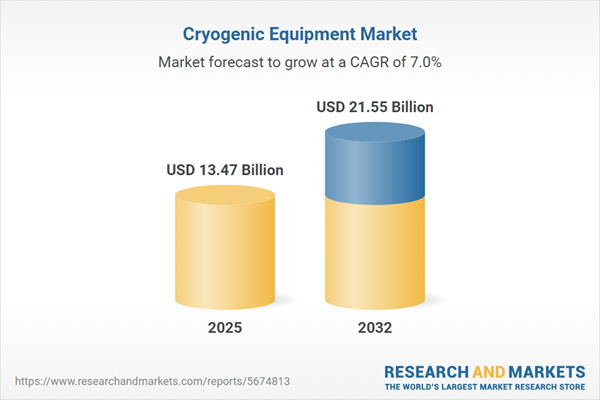Speak directly to the analyst to clarify any post sales queries you may have.
The cryogenic equipment market is evolving rapidly as industries adopt advanced low-temperature technologies to meet efficiency, safety, and sustainability objectives. Executive leaders require current, actionable intelligence to address the pace of change and emerging opportunities in this sector.
Market Snapshot: Cryogenic Equipment Market Growth
The cryogenic equipment market expanded from USD 12.58 billion in 2024 to USD 13.47 billion in 2025, with strong momentum projected through 2032 at a CAGR of 6.95%, reaching USD 21.55 billion. This growth is fueled by rising demand for reliable low-temperature processing in sectors such as electronics, food processing, healthcare, and industrial manufacturing. Stakeholders recognize the increasing importance of integrated solutions, digital monitoring, and evolving regulatory standards across all regions.
Cryogenic Equipment Market: Scope & In-Depth Segmentation
- Product Types: Centrifugal and reciprocating pumps, storage tanks (over and under 1000 L and 3000 L), transfer hoses (short, standard, and extended lengths), and vacuum jacketed pipes.
- Cryogen Varieties: Liquid nitrogen, argon, and oxygen, each catering to application-specific requirements and regional regulatory needs.
- End-Use Industries: Electronics (including display manufacturing and semiconductors), food processing, healthcare (covering hospitals and research labs), and diverse industrial manufacturing such as automotive, chemical processing, and metal fabrication.
- Distribution Channels: Direct manufacturer engagement, OEM partnerships, authorized and independent distributors, and emerging online sales platforms.
- Applications: Filling and transfer, storage (both bulk and cylinder formats), and transportation with ISO containers and road tankers.
- Regional Markets: Americas (United States, Canada, Mexico, key Latin American countries), EMEA (core European, Middle Eastern, and selected African markets), and Asia-Pacific, with distinct patterns of adoption and infrastructure maturity.
- Leading Players: Leading companies include Air Liquide S.A., Linde plc, Chart Industries, Air Products and Chemicals, Cryoport, and key regional manufacturers and distributors.
Key Takeaways for Senior Decision-Makers
- Materials science and digital integration are reshaping operational efficiency, with real-time monitoring and predictive diagnostics minimizing equipment downtime and optimizing lifecycle performance.
- Sustainability initiatives are leading manufacturers to develop modular, upgradable systems that reduce waste and energy use while supporting compliance with tightening regulatory mandates.
- The competitive landscape is defined by strategic partnerships, acquisitions, and technological innovation across pump, storage, and vacuum insulation segments.
- Supply chain strategies increasingly focus on regional service hubs, risk mitigation, and agility due to policy shifts and the need for resilient sourcing models.
- Variations in infrastructure, regulation, and end-use requirements across Americas, EMEA, and Asia-Pacific drive demand for locally tailored solutions and customer support strategies.
- Providers offering robust technical support, rapid response, and compliance-centric service models are capturing higher-value contracts and expanding global footprints.
Impact of United States Tariffs in 2025
Recent U.S. tariff measures on specialized pumps, storage tanks, hoses, and vacuum jacketed components have prompted supply chain adjustments and cost recalculations for both domestic and global manufacturers. Procurement teams increasingly balance the higher acquisition costs associated with tariffs against enhanced reliability and service offerings. As a result, supplier relationships are evolving, and many organizations are optimizing logistics and regional sourcing to ensure timely delivery and compliance with new rules.
Research Methodology & Data Sources
This report utilizes a multi-stage methodology combining in-depth primary interviews with subject matter experts and a comprehensive review of secondary sources, including regulatory filings, patent archives, and trade guidelines. Data validation involved analytical cross-tabulation and scenario-based assessments, ensuring objective and actionable insights for stakeholders.
Why This Report Matters to Cryogenic Equipment Stakeholders
- Strategic leaders gain a robust foundation to anticipate regulatory shifts, technology advancements, and market-access implications, enabling agile responses to industry volatility.
- Comprehensive segmentation and regional analysis equip procurement, operations, and investment teams with the detail needed for tailored decision-making and risk mitigation.
- This research underpins decisions regarding new product development, M&A opportunities, and alignment of supply chain strategy to policy and market trends.
Conclusion: Navigating the Cryogenic Equipment Landscape Ahead
Organizations that prioritize innovation, operational agility, and partnership-driven strategies will be best positioned to leverage emerging opportunities and navigate challenges in the evolving cryogenic equipment market. Informed decision-makers can drive sustainable growth and resilience amid global industry transformation.
Additional Product Information:
- Purchase of this report includes 1 year online access with quarterly updates.
- This report can be updated on request. Please contact our Customer Experience team using the Ask a Question widget on our website.
Table of Contents
3. Executive Summary
4. Market Overview
7. Cumulative Impact of Artificial Intelligence 2025
List of Figures
Samples

LOADING...
Companies Mentioned
The key companies profiled in this Cryogenic Equipment market report include:- Air Liquide S.A.
- Linde plc
- Air Products and Chemicals, Inc.
- Chart Industries, Inc.
- Messer Group GmbH
- Taiyo Nippon Sanso Corporation
- Cryogenic Industries, Inc.
- Cryoport, Inc.
- Cryostar SAS
- Technifab Products, Inc.
Table Information
| Report Attribute | Details |
|---|---|
| No. of Pages | 196 |
| Published | October 2025 |
| Forecast Period | 2025 - 2032 |
| Estimated Market Value ( USD | $ 13.47 Billion |
| Forecasted Market Value ( USD | $ 21.55 Billion |
| Compound Annual Growth Rate | 6.9% |
| Regions Covered | Global |
| No. of Companies Mentioned | 11 |









